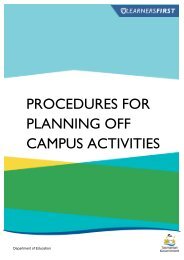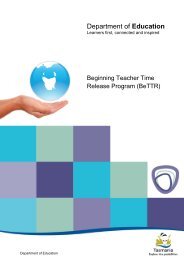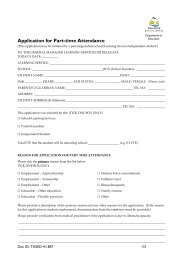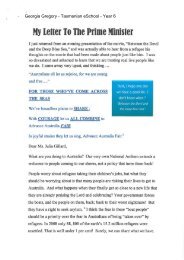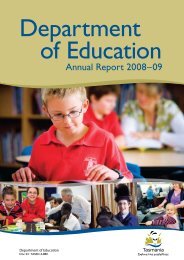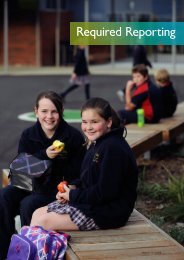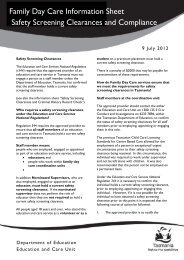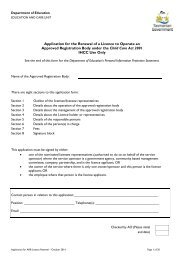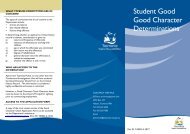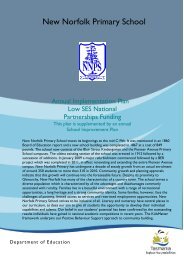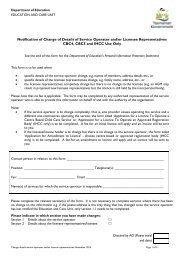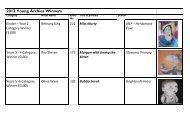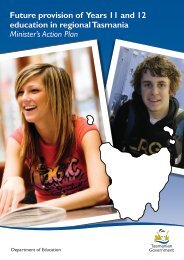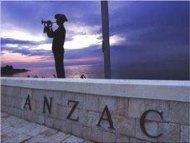Department of Education
DoE Annual Report 2010-2011 - Department of Education
DoE Annual Report 2010-2011 - Department of Education
- No tags were found...
Create successful ePaper yourself
Turn your PDF publications into a flip-book with our unique Google optimized e-Paper software.
RTBCTG is complemented by Smarter Schools National<br />
Partnerships for Literacy and Numeracy, and Low Socioeconomic<br />
Status School Communities. The National<br />
Partnerships are co-investments with the Australian<br />
Government that provide significant support for<br />
improving literacy and numeracy in schools. Teacher<br />
learning, and building teacher capability in a sustainable<br />
way, is a priority within the Tasmanian approach to the<br />
National Partnership for literacy and numeracy and<br />
has predominantly underpinned all actions in schools.<br />
Students in Years 5, 6, 7 and 8 are being specifically<br />
targeted for initiatives, and implementation is requiring<br />
primary and secondary schools to work together.<br />
Closing the<br />
Gap on<br />
Aboriginal<br />
<strong>Education</strong><br />
Outcomes<br />
The Tasmanian Closing the Gap strategy (2010–14)<br />
complements work through the Smarter Schools<br />
National Partnership for Literacy and Numeracy to lift the<br />
performance <strong>of</strong> Aboriginal students. This strategy aims<br />
to better meet the educational needs <strong>of</strong> Aboriginal<br />
students and improve performance through whole-<strong>of</strong><br />
school approaches to personalised learning, literacy and<br />
numeracy improvement and community engagement.<br />
A feature <strong>of</strong> the strategy is the identification <strong>of</strong> focus<br />
schools, based on high Aboriginal student enrolment<br />
and high educational need. Focus schools are receiving<br />
specialised support from Aboriginal <strong>Education</strong> Services<br />
to support inclusive teaching and improve community<br />
engagement.<br />
Many Aboriginal students in Tasmania achieve lower<br />
outcomes compared to their non-Aboriginal peers.<br />
A range <strong>of</strong> targeted strategies to improve outcomes<br />
are designed to close this gap. These strategies include:<br />
in-class tuition, personalised mentoring and tutoring,<br />
as well as support for speech, hearing and other<br />
impediments that hinder progress. Specialised<br />
pr<strong>of</strong>essional learning for tutors that focuses on quality<br />
teaching programs and cultural awareness is also<br />
provided.<br />
The National Aboriginal and Torres Strait Islander <strong>Education</strong><br />
Action Plan (NATSIEAP) has enabled extension funding <strong>of</strong><br />
$1.9 million to support five NATSIEAP focus schools to<br />
incorporate the Raising the Bar Closing the Gap strategy<br />
into their schools—Raising the Bar Closing the Gap<br />
Indigenous extension. This program commenced in Term 1,<br />
2011 and will continue until December, 2012. The Raising<br />
the Bar Closing the Gap Indigenous extension program will<br />
help to accelerate literacy and numeracy achievement <strong>of</strong><br />
participating Aboriginal students.<br />
Literacy and<br />
numeracy<br />
learning<br />
initiatives<br />
The following funded literacy and numeracy initiatives<br />
occurred in 2010–11:<br />
• Learning Services Support for Schools – schools,<br />
in conjunction with their Learning Services, are<br />
best placed to develop individualised literacy and<br />
numeracy plans. Funding <strong>of</strong> $3 million in 2010–11<br />
was provided for Learning Services to support<br />
schools in literacy improvement. Schools have been<br />
supported with focused pr<strong>of</strong>essional learning and<br />
have been working together to interpret data and<br />
better diagnose and address the learning needs <strong>of</strong><br />
their students.<br />
• Literacy Grants – literacy intervention support was<br />
provided to schools with the highest <strong>Education</strong>al<br />
Needs Index (ENI).<br />
• Reading Recovery – a school-based literacy<br />
intervention for Year 1 was a funded improvement<br />
strategy with 56 schools participating in 2010.<br />
• Reading Together – a family literacy program which<br />
supports pre-school and adult literacy at 18 locations<br />
statewide.<br />
• Flying Start – the Flying Start resource is a staffing<br />
allocation made to primary and combined schools<br />
to support literacy teaching and learning from<br />
Kindergarten through to Year 2. All primary and<br />
combined schools provided this early intervention in<br />
literacy.<br />
• Student Links – an initiative to improve outcomes<br />
for students moving from Year 6 to Year 7, which<br />
provides additional support to schools and<br />
communities to address the specific needs <strong>of</strong> students<br />
at risk during transition periods. Projects and programs<br />
vary and include the provision <strong>of</strong> personal support<br />
through case management and curriculum designed<br />
around individual student needs and capacities.<br />
• Partnerships in Teaching Excellence (PiTE) – this preservice<br />
training program is in part used to better<br />
prepare beginning teachers as literacy/numeracy<br />
teachers and improve pr<strong>of</strong>essional learning for<br />
experienced teachers; 20 students were part <strong>of</strong> this<br />
initiative in 2010 with 23 students participating in 2011.<br />
Literacy and<br />
Numeracy<br />
Plans<br />
In response to the NAPLAN 2011 results, a strategy<br />
has been developed and implemented. The strategy will<br />
see each school carefully analysing their school data to<br />
identify specific aspects <strong>of</strong> literacy and numeracy that<br />
require further focus. Schools have also been provided<br />
with additional data to assist with their analysis as well<br />
as direct access to web-based teaching resources and<br />
strategies and support. In addition the Curriculum and<br />
<strong>Education</strong>al Performance Services teams are providing<br />
further school level support, including help desk<br />
assistance to aid their analysis and planning.<br />
Principals and teachers are translating their findings into<br />
revised Literacy and Numeracy Plans at the school level,<br />
and implementing teaching and learning strategies to<br />
address the identified areas <strong>of</strong> future focus.<br />
Pre-Compulsory and Compulsory <strong>Education</strong> – Literacy and Numeracy<br />
23




